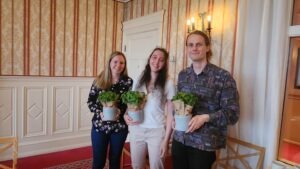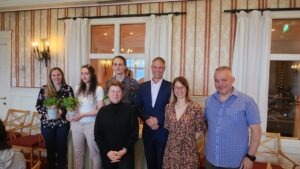The way we communicate about antibiotic resistance has a lot to say about whether the message gets across - successful 3rd annual meeting for the CAMRIA center
The West Norwegian Center for Antibiotic Resistance (CAMRIA – Combatting Anti-Microbial Resistance with Interdisciplinary Approaches) opened in 2020 and will use an interdisciplinary approach to one of the biggest health threats we face: antibiotic resistance. More and more antibiotics stop working against bacteria that make us sick and it is expensive and time-consuming to look for new drugs that can be used to fight dangerous bacteria.CAMRIA is led by Professor Nina Langeland from the Faculty of Medicine at UiB and collaborates both internally with several faculties at UiB, but also with Haukeland University Hospital and Stavanger University Hospital. The Trond Mohn Research Foundation supports both the centre’s operations and three research projects under CAMRIA with a total of NOK 25.7 million. The University of Bergen, Haukeland University Hospital and Stavanger University Hospital collectively contribute similar support to the center and the research projects.

CAMRIA recently organized its third annual meeting at Solstrand Hotel, where the centre’s researchers, the board and guests had the opportunity to exchange knowledge and discuss research results. On the first day of the meeting, the young researchers were in focus – a total of 12 PhD fellows and post-docs presented their projects, moderated the sessions and at the same time competed for this year’s awards for the best lectures. Olav Aga from UiB, Marit Hetland from Stavanger University Hospital and Liza Nguyen Van Sang from the University of Stavanger were named winners of the presentation award on the first evening.On day 2, the researchers discussed different approaches to communication. Professor Anne Lise Fimreite from the Department of Comparative Politics at UiB showed data from the Citizens’ Panel on the population’s knowledge of antibiotics and antibiotic resistance. It turned out that Norwegian citizens are better informed about the topics than the population in the rest of Europe, and understanding of the major health challenge posed by resistant bacteria can be increased by the use of information material in understandable language. Professor Emerita Jocelyne Arquembourg from the Université Sorbonne Nouvelle in Paris spoke about the history and culture of antibiotics use in France where some antibiotics were used to fatten animals in industrial agriculture for a number of years. She also showed campaigns for doctor’s offices about less use of antibiotics. Professor Jens Elmelund Kjeldsen from UiB’s Department of Information and Media Science engaged the audience in lively discussions in an interactive lecture on handling a media scandal.

Professor Arnfinn Sundsfjord from the University of Tromsø, head of the Center for new antibacterial strategies CANS (https://uit.no/research/cans), which is supported by the foundation’s sister foundation, the Tromsø Research Foundation and who also leads a large national project for research into antibiotic resistance supported by TMF’s national program for antibiotic resistance closed the seminar with an introduction to a new Nordic research network of Nordic AMR centers that includes both CANS and CAMRIA.
Photos in this article and in the ingress: Karolina Poltorak
